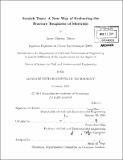| dc.contributor.advisor | Franz-Josef Ulm. | en_US |
| dc.contributor.author | Akono, Ange-Therese | en_US |
| dc.contributor.other | Massachusetts Institute of Technology. Dept. of Civil and Environmental Engineering. | en_US |
| dc.date.accessioned | 2011-06-20T15:53:11Z | |
| dc.date.available | 2011-06-20T15:53:11Z | |
| dc.date.copyright | 2011 | en_US |
| dc.date.issued | 2011 | en_US |
| dc.identifier.uri | http://hdl.handle.net/1721.1/64571 | |
| dc.description | Thesis (S.M.)--Massachusetts Institute of Technology, Dept. of Civil and Environmental Engineering, 2011. | en_US |
| dc.description | Cataloged from PDF version of thesis. | en_US |
| dc.description | Includes bibliographical references (p. 126-130). | en_US |
| dc.description.abstract | This thesis develops, validates and implements a fracture mechanics model for the assessment of the fracture toughness of materials from scratch tests. Dimensional Analysis highlights two major processes at work during scratch tests: plastic yielding and fracture dissipation. An original set-up of controlled laboratory tests on paraffin wax allows us to identify fracture processes as predominant. An analytical model for scratch tests with a rectangular blade and a back-rake angle is then developed. This model applies to linear elastic isotropic brittle materials and links the fracture toughness to the average horizontal and vertical forces recorded in the scratch test, and to the width and depth of the scratch. Finite Element simulation show that the model is highly accurate for back-rake angles smaller than 25'. From the model, an inverse technique to predict the fracture toughness is developed and implemented. This technique is validated for scratch tests on cement paste, Jurassic limestone, red sandstone and Vosges sandstone. and applied to oil cements hydrated at high temperature and pressure. The application shows that the scratch tests is highly reproducible. almost non-destructive, and not more sophisticated than classical strength-of-materials tests; which makes this *old' technique highly attractive for both materials research and industrial applications. | en_US |
| dc.description.statementofresponsibility | by Ange-Therese Akono. | en_US |
| dc.format.extent | 130 p. | en_US |
| dc.language.iso | eng | en_US |
| dc.publisher | Massachusetts Institute of Technology | en_US |
| dc.rights | M.I.T. theses are protected by
copyright. They may be viewed from this source for any purpose, but
reproduction or distribution in any format is prohibited without written
permission. See provided URL for inquiries about permission. | en_US |
| dc.rights.uri | http://dspace.mit.edu/handle/1721.1/7582 | en_US |
| dc.subject | Civil and Environmental Engineering. | en_US |
| dc.title | Scratch tests : a new way of evaluating the fracture toughness of materials | en_US |
| dc.title.alternative | New way of evaluating the fracture toughness of materials | en_US |
| dc.type | Thesis | en_US |
| dc.description.degree | S.M. | en_US |
| dc.contributor.department | Massachusetts Institute of Technology. Department of Civil and Environmental Engineering | |
| dc.identifier.oclc | 727033228 | en_US |
